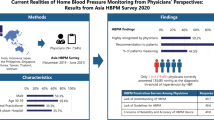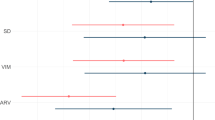Abstract
Regular measurement of the blood pressure (BP) is necessary to monitor the treatment of hypertension, and self-measurement is one technique of obtaining such measurements. The aim of this study was to investigate the experiences of individuals who have carried out home BP measurement. A qualitative method using semistructured interviews was used with 13 subjects. These were adults with hypertension who had previous experience of measuring their own BP, and were recruited to the study from one UK general medical practice. Interviews were recorded and transcribed, and data from the interviews have been analysed using phenomenological principles and identifying ‘meaning units.’ The findings suggest that participants were willing to carry out home measurements and several were pleased to have been asked to be more involved in their own management. All found the technique straightforward. Most noted marked variability in the day-to-day BP measurements. Several exhibited the ‘white coat’ phenomenon (spuriously raised BP in certain settings only). Some participants showed considerable know-ledge of hypertension and its consequences. They reported being aware of their own BP level and whether this was within acceptable limits. They also reported being willing to take further measurements, and to consider adjusting their treatment in the light of these measurements. Other participants showed less knowledge and enthusiasm, and considered the management of hypertension to be the doctor's job. The findings suggest that for some individuals home BP measurement is acceptable. They also help to explain why, for some individuals, it is not. Using the findings, a number of changes to current practice could be made, which might make home measurements more acceptable and easier to perform. As a result, a new proforma for use in everyday practice has been designed. The study shows that there is considerable scope for sharing BP measurement and management decisions in hypertension with patients themselves.
This is a preview of subscription content, access via your institution
Access options
Subscribe to this journal
Receive 12 digital issues and online access to articles
$119.00 per year
only $9.92 per issue
Buy this article
- Purchase on Springer Link
- Instant access to full article PDF
Prices may be subject to local taxes which are calculated during checkout
Similar content being viewed by others
References
Pickering TG . BP monitoring outside the office for the evaluation of patients with resistant hypertension. Hypertension 1988; 11 (Part 2): II96–100.
Rickerby J . The role of home BP measurement in managing hypertension—an evidence-based review. J Human Hypertension 2002; 16: 469–472.
Melville A . Complications of diabetes. Effective Health Care 2000; 6: 1.
Zarnke KB et al. A randomized study comparing a patient-directed hypertension management strategy with usual office-based care. Am J Hypertens 1997; 10: 58–67.
Cresswell J . Qualitative Inquiry and Research Design. Sage: Thousand Oaks, CA, 1998.
Chapman KR et al. Improving patient compliance with asthma therapy. Respir Med 2000; 94: 2–9.
McInnes GT . Integrated approaches to management of hypertension: promoting treatment acceptance. Am Heart J 1999; 138 (Part 2): 252–225.
Crotty M . Phenomenology for Nursing. Pearson: South Melbourne, 1996.
Hycner R . Some guidelines for the phenomenological analysis of interview data. Hum Stud 1985; 8: 279–303.
Moustakas C . Phenomenological Research Methods. Sage: Thousand Oaks, CA, 1994.
Aylett M, Marples G, Jones K . Home BP monitoring: its effect on the management of hypertension in general practice. Br J Gen Pract 1999; 49: 725–728.
Wallston BD, Wallston KA . Locus of control and health: a review of the literature. Health Educ Monogr 1978; 6: 107–117.
Minkler M . Personal responsibility for health? A review of the arguments and the evidence at century's end. Health Educ Behav 1999; 26: 121–140.
Goldsteen RL, Counte MA, Goldsteen K . Examining the relationship between health locus of control and the use of medical care services. J Aging Health 1994; 6: 314–335.
Melville A . Complications of diabetes: renal disease and promotion of self-management. Effective Health Care 2000; 6: 7–9.
Coster S et al. Review: self monitoring does not improve blood glucose control in type 2 diabetes mellitus. Diabetes Med 2000; 17: 755–761.
Lorig K et al. Evidence suggesting that a chronic disease self-management program can improve health status while reducing hospitalisation: a randomised trial. Med Care 1999; 37: 5–14.
Acknowledgements
This study has been supported by an NHS Executive Anglia and Oxford Region Primary Care Research and Development Enterprise Award, and by a grant from the NHS Research and Development levy.
We thank Professor Jackie Campbell and Dr Susan Corr of University College Northampton for support and advice, and Verna Kitchener of the Primary Care Research Consortium for Northamptonshire for secretarial help.
Author information
Authors and Affiliations
Corresponding author
Appendices
Appendix A
Framework for interviews
There will not be a formal questionnaire for this study.
The aim of a phenomenological study is to discover the views and feelings of the subjects, and to allow them to express them in their own words. For this reason, open-ended questions are used to encourage each subject to explain their own ideas.
A framework of a few main questions will be used:
-
‘Tell me about your high blood pressure.’
-
‘How difficult was it to measure your own blood pressure?’
-
‘How did you feel about measuring your own blood pressure?’
-
‘What did you think about the results?’
-
‘Did you discuss the results with your doctor? Was this useful?’
-
‘How do you feel about your high blood pressure now?’
Subjects' answers may be explored and clarified as necessary.
Data obtained in this way are wide ranging and unstructured, but there is less risk of missing important aspects than when using more structured questioning.
Appendix B
Home blood pressure monitoring
Your doctor would like you to measure your own blood pressure at home for a week. Treatment of your blood pressure may need to be started or adjusted: home readings will help to prove whether this is necessary, or help to avoid unnecessary medication.
Patient's name:
Target average BP level: Usually 140/85 (130/80 if diabetic)
(average=sum of all readings/number of readings)
Use the machine while sitting comfortably with your arm (either arm is OK) resting on a table in front of you and the cuff firmly around the upper arm.
The readings will vary—probably no two will be the same. It is the average level that matters.
Please take readings twice or three times a day for 7 days. Write them in the table below (See Table A1). Ideally please take measurements at home in the mornings and evenings, and if possible one in the middle of the day, at work, if necessary.
The average of these readings should be less than the target level written above.
We suggest that you discuss the results with your doctor afterwards. (See Table A1)
Rights and permissions
About this article
Cite this article
Rickerby, J., Woodward, J. Patients' experiences and opinions of home blood pressure measurement. J Hum Hypertens 17, 495–503 (2003). https://doi.org/10.1038/sj.jhh.1001582
Received:
Revised:
Accepted:
Published:
Issue Date:
DOI: https://doi.org/10.1038/sj.jhh.1001582
Keywords
This article is cited by
-
Blood pressure self-monitoring in pregnancy (BuMP) feasibility study; a qualitative analysis of women’s experiences of self-monitoring
BMC Pregnancy and Childbirth (2017)
-
Interpreting and acting upon home blood pressure readings: a qualitative study
BMC Family Practice (2013)
-
The influence of self-owned home blood pressure monitoring (HBPM) on primary care patients with hypertension: A qualitative study
BMC Family Practice (2011)



